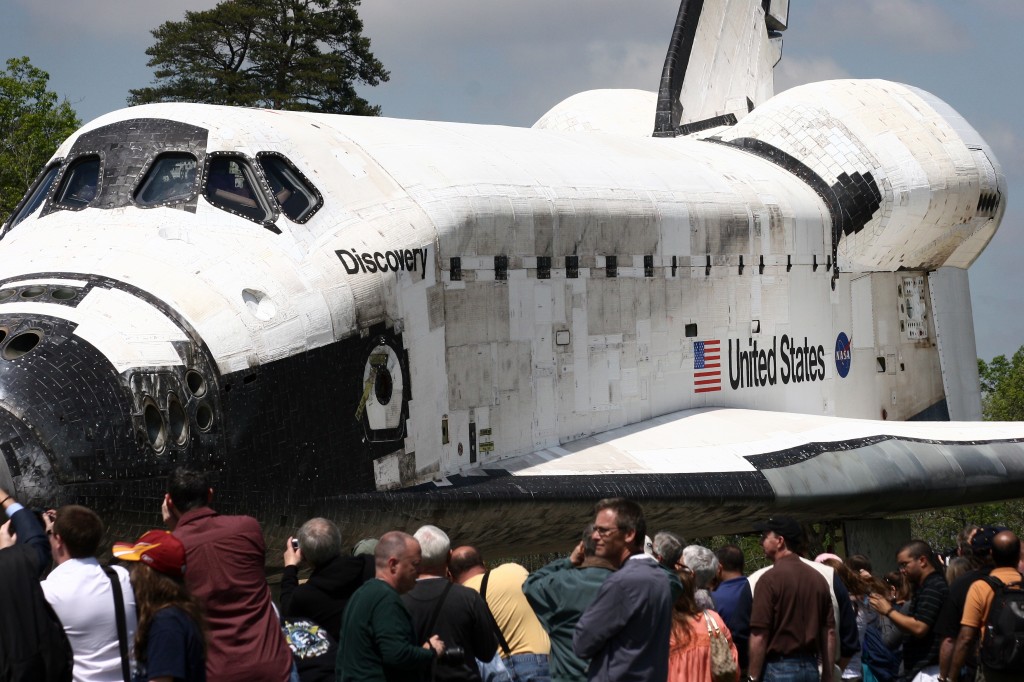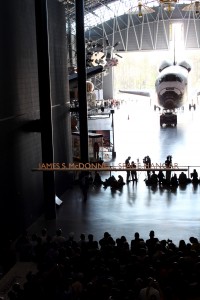20 April 2012
Sadness, frustration, and ultimately admiration surround space shuttle Discovery’s welcome to Smithsonian
Posted by mcadams

Space shuttle enthusiasts snap photos of Discovery on display outside the Steven F. Udvar-Hazy Center, the Smithsonian’s National Air and Space Museum companion facility near Dulles Airport, on 19 April before the shuttle was moved into a hangar at the center. Photo by Mary Catherine Adams, AGU.
It’s quite a legacy: The most launches into space for any one vehicle (39 if you’re counting); a trip to low-Earth orbit while nestling the Hubble Space Telescope like a proud mother carrying her baby; launching on both “Return to Flight” missions after two comrades were lost – Challenger in1986 and Columbia in 2003; and returning John Glenn to orbit, 36 years after he became the first American to make that journey there. No wonder Discovery – perhaps NASA’s most praise-worthy space shuttle orbiter – is being parked in the Smithsonian. (Never mind that its prototype, the Enterprise, is being quietly ushered away to make room.)
Discovery’s trip to its new home drew a fair bit of attention in the Washington, D.C., area. When the parking lot at the Steven F. Udvar-Hazy Center – the Smithsonian’s National Air and Space Museum companion facility near Dulles Airport that will serve as Discovery’s new home – filled on Tuesday ahead of the orbiter’s mid-morning flyover, drivers stopped along the sides of busy roads and stood in the grass for a peek, just as onlookers stood on the beaches of Florida to watch the first Space Shuttle launch three decades ago.
A temporary indoor display featuring NASA’s Mars Science Laboratory Curiosity rover, currently bound for Mars, and a scale model of the Orion vehicle (the shuttle’s successor), spoke to hopes for the future of space science exploration.

People crowd to take pictures of Space Shuttle Discovery as it is towed into the space hangar at the Steven F. Udvar-Hazy Center, the Smithsonian’s National Air and Space Museum companion facility near Dulles Airport on 19 April, 2012. Photo by Mary Catherine Adams, AGU.
Still, as we ogled the two shuttles parked nose-to-nose outside on the tarmac, there was an undercurrent of sadness at this very visible bookend of the space shuttle program.
The outdoor viewing areas also turned some people’s sadness into frustration. Unfortunately, what was billed online as an event for the public turned out to be a largely media-focused affair. The space exploration fans standing near me had to wait for a break in the bobbing heads of the media before snapping a picture of Glenn or one of the other 20-plus astronauts onstage a half a football field away.
As the day wound down, however, attitudes of admiration and awe persisted. Crowds that had spent the afternoon touching space shuttle tiles and learning paper airplane aerodynamics gathered outside once more to watch Discovery being towed into the hanger. Enthusiasts of all ages, many sporting a “Discovery World Tour” or “STS-135” t-shirt with the screen-printing already cracked and the dye already faded stood three deep against the barricades, and lowered their video cameras to clap and cheer as Discovery’s wings and tail slipped into the hangar.
A little boy, perhaps eight years old, threw rocks from a small collection he had amassed, watching as they broke into pieces on the ground: Red rocks and beige rocks and gray rocks, some with matching interiors, some without. The spirit of discovery, I was reminded, is still around. Which astronauts I wondered spent their childhoods smashing apart rocks?
-Mary Catherine Adams, AGU public information specialist
To see more photos from Discovery’s welcome ceremony at Udvar Hazy, click here to go to the AGU Facebook page.










 GeoSpace is a blog on Earth and space science, managed by AGU’s Public Information staff. The blog features posts by AGU writers and guest contributors on all sorts of relevant science topics, but with a focus on new research and geo and space sciences-related stories that are currently in the news.
GeoSpace is a blog on Earth and space science, managed by AGU’s Public Information staff. The blog features posts by AGU writers and guest contributors on all sorts of relevant science topics, but with a focus on new research and geo and space sciences-related stories that are currently in the news.